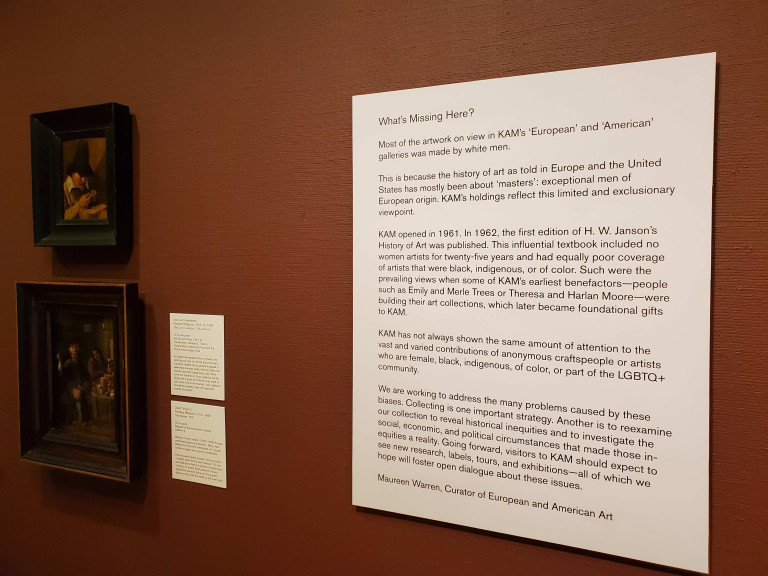Krannert Art Museum pushes for better representation in its collections

This sign and two others hang in the Krannert Art Museum, asking visitors to think critically about the art they see, how it got to the museum and who is represented in art collections. Maureen Warren, the curator who wrote the text on each one, said she f Owen Henderson
CHAMPAIGN — In recent years, many art institutions have been grappling with the lack of diversity in the artistic works they perform or display.
The Krannert Art Museum at the University of Illinois is no exception.
The museum curators have been making efforts to more prominently feature work by non-white, non-Western artists for years, but one hurdle they’ve encountered is making sure artists are showcased in more permanent ways, according to Amy Powell, the curator of the Modern and Contemporary Exhibit.
“The challenge is that a lot of the work gets presented in temporary exhibitions and then goes away,” Powell said.
She said parts of the gallery collections, such as the Trees Gallery of European and American Art, overwhelmingly feature works by white, male artists.
This is partly to do with the collectors who originally donated the art to the museum years ago, said Maureen Warren, the curator of the European and American gallery.
The gift, which contained 40 paintings by the “old masters” of European art, was well-intentioned and appreciated, but it was reflective of the standards and priorities of the 1940s and ‘50s surrounding art and artists, Warren said.
Since having conversations with museum director Jon Seydl in 2020, Warren has written and posted signs asking visitors to consider who isn’t represented in this collection.
“It’s really explaining that art history as a discipline was progressing in a way that was very much along the same, narrow, [cisgender, heterosexual], white male, white supremacist notion of what made something the best, most elite, most valuable in terms of art,” Warren said.
In the Art Since 1948 gallery, a much wider variety of artists is represented, with many works from Latino, Native North American, Black and LGBTQ artists prominently featured.
Kristen Sandoval, a University of Illinois student in social work who also works at the museum, said she grew up with a lot of Mexican art in her life and that she’s appreciated the efforts the museum has been making.
“Right around the corner from my house was the National Museum of Mexican Art,” Sandoval said. “So, seeing the Mexican art there for so many years and coming here, it was different. Usually, the museum there focuses only on Mexican art, while this one, we’re starting to see now a bigger range of artists.
“I think they’re making a good step in the right direction.”
Of the efforts by museums and art institutions more broadly, Powell said, “Hopefully it’s not just a moment, that these kinds of representations are here to stay, which we’re certainly interested in here.”

